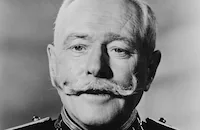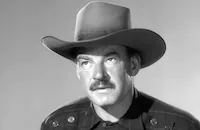The Fighting Guardsman

Brief Synopsis
Cast & Crew
Henry Levin
Willard Parker
Anita Louise
Janis Carter
John Loder
Edgar Buchanan
Film Details
Technical Specs

Synopsis
In 1789, as King Louis XVI and his court wallow in extravagance, rebellion smoulders throughout France. Among those fighting for freedom are the masked bandit Roland and his band of followers, who are known as the Companions of Jéhu. In reality, Roland is the Baron de Saint-Hermaine, an aristocrat who, angered by the injustice perpetrated by his class, has assumed the identity of an outlaw. One day, Roland and his followers rob a mail coach transporting a shipment of the king's gold. Unknown to the bandits, the coach is also carrying King Louis, who is traveling incognito with his arrogant companion, Gaston de Montrevel. The other passengers on the coach are Sir John Tanlay, an Englishman, and Hyperion Picot, a disgruntled subject of the king. After delivering the stolen gold to a church and some starving children, Roland is greeted by his sweetheart, the noblewoman Amelie de Montrevel, who warns him that her brother, Gaston, a dangerous ally of the king, is returning home. Later, as the coach passengers dine at the Golden Pheasant Inn, Picot bemoans the fact that because he stowed his gold with a government shipment, it was also stolen by robbers. Just then, Roland appears and returns Picot's gold. Roland departs, but soon reappears as the baron, with his servant Pepe, in tow. When Pepe denounces the king, Gaston strikes him, causing Roland to defend his servant's honor with his sword. As the two aristocrats duel, Pepe scampers out of the inn and joins the outlaws waiting in the woods. After one of the band, posing as a police official, halts the duel, Gaston notices that the king is smitten by Christine Roualt, the innkeeper's daughter. Upon returning to their hideout in a deserted abbey, Montebar, one of the bandits, criticizes Roland for sparing Gaston's life and accuses him of partisanship with the aristocracy. Roland, however, wins a vote of confidence from his followers and proposes taking the king hostage and forcing him to sign a document freeing the peasants. Noting that Christine has informed him that Louis, a guest at the inn, has invited her to his summer villa, Roland then suggests using the innkeeper's daughter as bait. As the Companions of Jéhu and Christine plot their strategy, Amelie bursts into their hideout to warn them that Sir John, her brother's houseguest, is on his way to investigate reports that the abbey is haunted. After he is captured in the woods by the outlaws, Sir John recognizes Roland as the baron and informs the outlaws that his employer, a London banking house, has sent him to evaluate a loan that Louis has requested, using France as his collateral. When word comes that the king has dismissed parliament, Sir John offers the rebels his sympathy and pledges to keep their hideout secret. Meanwhile, at the king's villa, Berton, the prefect of police, discusses a trap he has set for the bandits. Overhearing the plans, Christine warns Roland, and after the band avoids capture, Berton begins to suspect that Sir John may be Roland's accomplice. Christine, who is in love with Roland and is jealous of Amelie, suggests to the king that a marriage between Sir John and Amelie would abolish any populist feelings that the Englishman might harbor. Applauding Christine's ingenuity, the king invites Sir John and the de Montrevel family to his villa. To insure that the king will force Amelie to marry Sir John, Christine makes Louis jealous by flirting with the Englishman. At dinner one night, the king is in the midst of announcing the marriage of Sir John and Amelie when Roland, dressed as the baron, joins the dinner guests. When Berton mentions that he suspects the bandits are headquartered at the abandoned abbey, Louis orders Gaston to lead the guard on an assault of the abbey. Christine distracts the dinner guests by pretending to faint so that Roland can sneak out to warn his compatriots about the raid. Roland clashes with Gaston in the woods, and as the two men duel on horseback, Gaston pulls a pistol from his belt and takes aim at Roland just as Montebar fells the aristocrat from his horse with a well-aimed bullet. After the battle, the king sends for the baron and offers him a commission in the Royal Guard. As the two men speak, Amelie enters the room, and the king, anxious to be rid of his rival, Sir John, proclaims that he has arranged the wedding for that evening. Just as Amelie is about to protest, Berton reports that Gaston has been killed by Roland. Out of sympathy for Amelie's loss, the king offers to postpone the ceremony, but Amelie, blaming Roland for her brother's death, insists that it be held as planned. As the king dresses for the festivities, Roland and Pepe sneak into his room and warn him that unless he grants reforms immediately, he will face rebellion later. Meanwhile, Amelie, dressed in her wedding gown, is sobbing in her room when Sir John enters and informs her that Roland was not responsible for her brother's death. The king is about to consent to Roland's demands when Sir John knocks at the door, and Pepe, startled, fires his gun, thus alerting the guards. After the king accidentally shoots Christine while aiming at Roland, Sir John takes up a saber and joins forces with the rebels. Just as the guards capture Roland, the peasants rebel, invading the chateau and taking the king prisoner. His mission completed, Sir John wishes Roland luck and returns to England. When Roland proclaims that his place is with the people, Amelie responds that her place is with him.

Director

Henry Levin
Cast

Willard Parker

Anita Louise

Janis Carter

John Loder

Edgar Buchanan

George Macready
Lloyd Corrigan

Elisabeth Risdon

Ian Wolfe

Ray Teal
Victor Kilian

Charles Halton
Maurice Tauzin
Charles Waldron
Ethan Laidlaw

Shelley Winter
Belle Mitchell
Michael Mark
Bobby Frasco
Al Luttringer
Dick Alexander
Edith Evanson
Paul Smith
Robert Barron
William E Lawrence
Eddie Abdo
Stanley Price
Alfred Allegro
George Magrill
Gene Stutenroth
Ted Hecht

Hope Landin
Lester Sharpe
Stan Jolley

Harry Cording
Bob Cason
Glen Mccarthy
Tommy Coats
Post Park
Newt Kirby
John Hawks
Crew
Gert Anderson
Edward Dein
Philip Faulkner
Ralph Faulkner
Louis Germonprez
Stephen Goossón
Burnett Guffey
Walter Holscher
Thelma Hoover
Michel Kraike
Viola Lawrence
Vera Mikol
Robert Priestley
Paul Sawtell
Marlin Skiles
Franz Spencer
M. W. Stoloff
Edwin L. Wetzel

Film Details
Technical Specs

Articles
The Fighting Guardsman -
By Richard Harland Smith

The Fighting Guardsman -
Quotes
Trivia
Notes
This picture's title is presented onscreen as Alexandre Dumas' The Fighting Guardsmen. According to a pre-production Hollywood Reporter news item, the picture was orginally to star Leslie Brooks, Larry Parks and John Calvert. Although a Hollywood Reporter production chart places Ted Donaldson in the cast, his appearance in the released film has not been confirmed. Onscreen credits list M. W. Stoloff as music director, but the Daily Variety review and Columbia production credits list Marlin Skiles as music director. A Hollywood Reporter news item notes that some scenes were filmed in the Malibu Mountains and in Sherwood Forest near Los Angeles. According to the Daily Variety review, The Fighting Guardsman marked Willard Parker's first screen appearance since leaving the armed forces.














